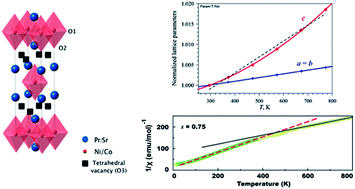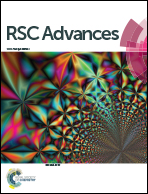Tuning the high-temperature properties of Pr2NiO4+δ by simultaneous Pr- and Ni-cation replacement†
Abstract
Novel Pr2−xSrxNi1−xCoxO4±δ (x = 0.25; 0.5; 0.75) oxides with the tetragonal K2NiF4-type structure have been prepared. Room-temperature neutron powder diffraction (NPD) study of x = 0.25 and 0.75 phases together with iodometric titration results have shown the formation of hyperstoichiometric oxide for x = 0.25 (δ = 0.09(2)) and a stoichiometric one for x = 0.75. High-temperature X-ray powder diffraction (HT XRPD) showed substantial anisotropy of the thermal expansion coefficient (TEC) along the a- and c-axis of the crystal structure, which increases with increasing the Co content from TEC(c)/TEC(a) = 2.4 (x = 0.25) to 4.3 (x = 0.75). High-temperature NPD (HT NPD) study of the x = 0.75 sample reveals that a very high expansion of the axial (Ni/Co)–O bonds (75.7 ppm K−1 in comparison with 9.1 ppm K−1 for equatorial ones) is responsible for such behaviour, and is caused by a temperature-induced transition between low- and high-spin states of Co3+. This scenario has been confirmed by high-temperature magnetization measurements on a series of Pr2−xSrxNi1−xCoxO4±δ samples. For compositions with high Ni content (x = 0.25 and 0.5) we synthesised K2NiF4-type oxides Pr2−x−ySrx+y(Ni1−xCox)O4±δ, y = 0.0–0.75 (x = 0.25); y = 0.0–0.5 (x = 0.5). The studies of the TEC, high-temperature electrical conductivity in air, chemical stability of the prepared compounds in oxygen and toward interaction with Ce2−xGdxO2−x/2 (GDC) at high temperatures reveal optimal behaviour of Pr1.35Sr0.65Ni0.75Co0.25O4+δ. This compound shows stability in oxygen at 900 °C and does not react with GDC at least up to 1200 °C. It features low TEC of 13 ppm K−1 and high-temperature electrical conductivity in air of 280 S cm−1 at 900 °C, thus representing a promising composition for use as a cathode material in intermediate temperature solid oxide fuel cells (IT-SOFC).



 Please wait while we load your content...
Please wait while we load your content...